Our Low FODMAP Vanilla Crescents are buttery, a bit crumbly and made with finely ground almonds or almond flour. The dough itself is not very sweet, but the sugary coating creates a sweet treat. You can also dip them in dark chocolate, as an alternative finish.

This recipe first appeared in my book, A Baker’s Field Guide to Christmas Cookies, but at the time it was not gluten-free. Here is our new version, which you can even enjoy during the Elimination Phase of the diet – gluten-free and lactose-free.
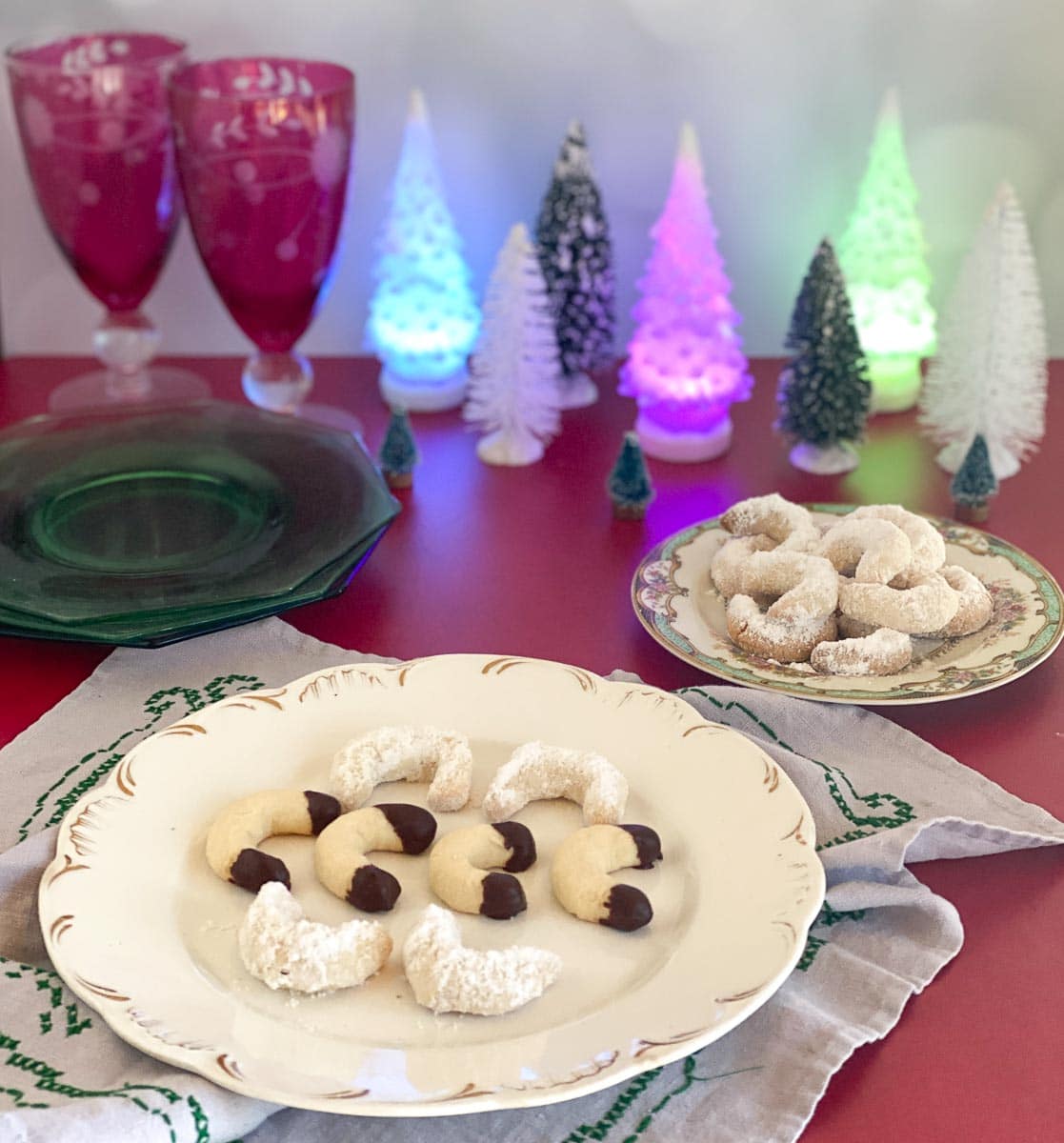
Classics Made Low FODMAP
This is a very old, classic recipe, yet still as popular as ever, particularly in Vienna where it is called Vanillekipferln. You will occasionally see these called Viennese, Austrian or German crescents. They are sometimes made with walnuts or hazelnuts. For a similar cookie, check out our Pecan Butterballs.

Vanilla Is A Key Ingredient
The vanilla flavor is quite prominent in these Low FODMAP Vanilla Crescents. Vanilla sugar is a common ingredient in many parts of Europe and professional bakers and even home cooks can find it in grocery stores – lucky for us the technique below makes it easy to prepare these cookies. You will need a fresh, moist, plump vanilla bean, although I give you options for using vanilla extract as well.

Whole Blanched Almonds vs. Fine Almond Flour
When I first developed this recipe, I called for whole blanched almonds. Blanched almonds have had their skin removed; they are not that easy to find, and can be pricey. Luckily when I developed the recipe, I included weight. This made it easy to translate to already ground, fine almond flour made from blanched almonds. I highly recommend a Bob’s Red Mill version, which is superfine, and perfect for this recipe. It has the right consistency.
Your choice of almond flour/meal really does matter. Trader Joe’s for instance has an almond meal that is skin on (lots of brown flecks) and quite coarse texturally in comparison. It would not work in this recipe.As always, but especially with baking, use what is called for.
Frequently Asked Questions
This recipe works beautifully with Better Batter Flour. It contains pectin and does not act like other flour. In particular, the ratio of wet ingredients to dry, when using this flour, is dramatically different from any other flours. Again, as always, but especially with baking, use what is called for.
This recipe is a 5-star recipe if you use vanilla bean. The result will be fragrant, elegant and superior to the same recipe using vanilla extract. But, vanilla beans are expensive and if you want to make this with vanilla extract, you can. Simply add 1 teaspoon of vanilla extract to the butter when making the dough.
And/or, see if you can find vanilla sugar and use that to replace the granulated sugar in the topping in addition to extract in the dough.
To make your own vanilla sugar after you do use a vanilla bean, simply bury the scraped pods in an airtight container with 4 cups (792 g) of sugar and let it sit for a week or so. Voila, vanilla sugar for future recipes.
We have set the serving size at 2 cookies. From a FODMAP perspective you could eat more, but we do not recommend it. While fat and sugar are not a FODMAP issue, they can exacerbate IBS symptoms for some. Use your best judgement when choosing what to eat, when to eat it, and how much to eat. Know your tolerances.
How To Make Our Cookies
For the Cookie: Place flour, almond flour and salt in bowl in a bowl and whisk together to aerate and combine.
Place butter in bowl of mixer and beat with flat paddle on medium-high speed until creamy, about 2 minutes.

Split the vanilla pod lengthwise with a sharp knife, then scrape half the vanilla bean seeds into the butter using a butter knife or spoon (reserve other half for topping). Beat butter for 1 minute to blend in the vanilla beans – or beat in 1 teaspoon vanilla extract in lieu of bean. Add confectioners’ sugar and continue beating until light and fluffy, about 3 minutes, scraping down the bowl once or twice. Beat in egg yolks.
Turn machine off, add about one-third of the flour mixture, then turn machine onto low-speed. Gradually add remaining flour, mixing just until blended, scraping down bowl once or twice.

Scrape dough onto large piece of plastic wrap. Use wrap to help shape a large, flat disc then cover with plastic wrap. Refrigerate at least 1 hour or until firm enough to roll.
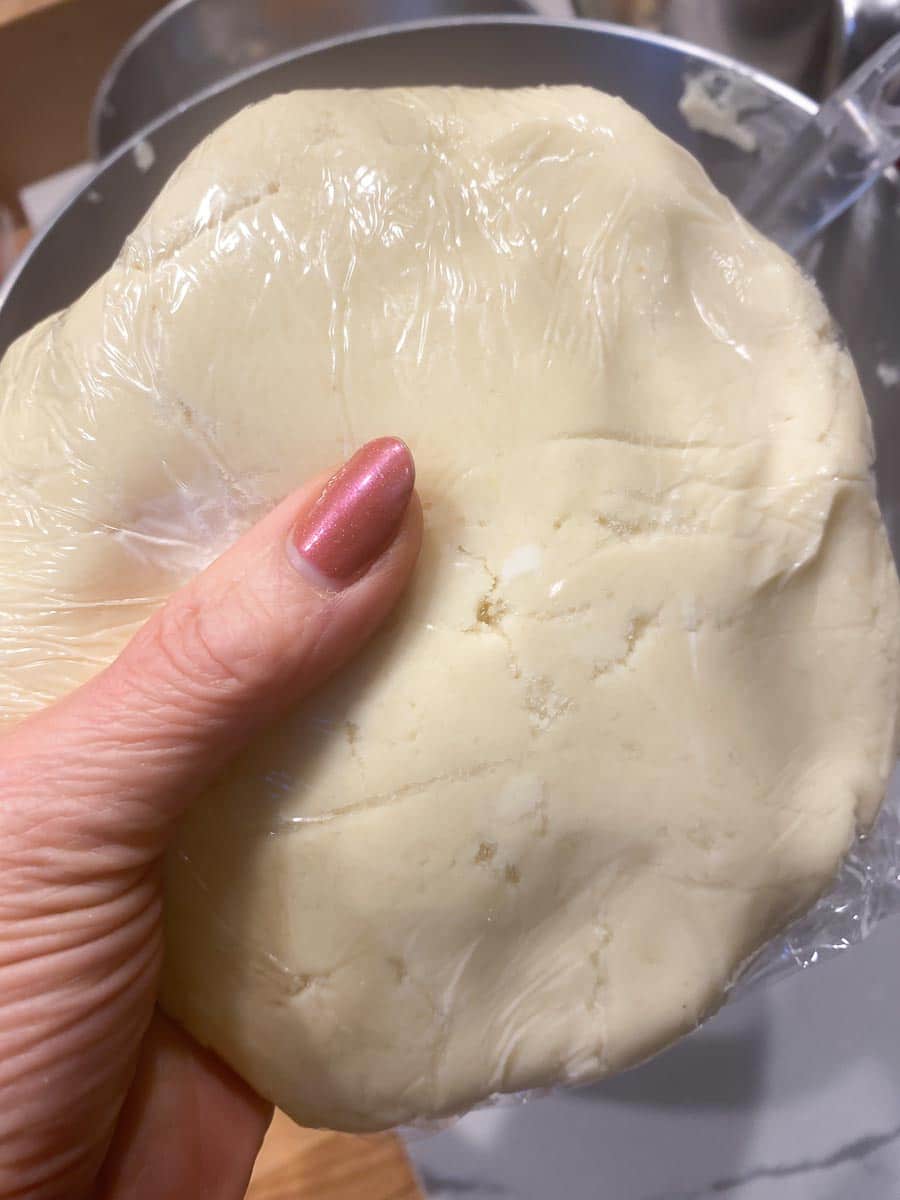
Dough may be refrigerated overnight in which case you may need it to soften a bit at room temperature before shaping. You may freeze dough up to 1-month double wrapped in plastic wrap; defrost in refrigerator overnight before proceeding.
For the Topping: Place granulated sugar and confectioners’ sugar in bowl of food processor fitted with metal blade. Split the remaining half vanilla pod lengthwise with a sharp knife, then scrape the vanilla bean seeds into the sugar mixture using a butter knife or spoon. Pulse on and off several times to disperse vanilla bean seeds. Pour vanilla sugar into a small bowl; set aside.
Preheat oven to 350°F (180°C). Line two half-sheet pans with parchment paper.
Roll dough between your palms or on work surface into 1/2-inch (12 mm) wide logs.
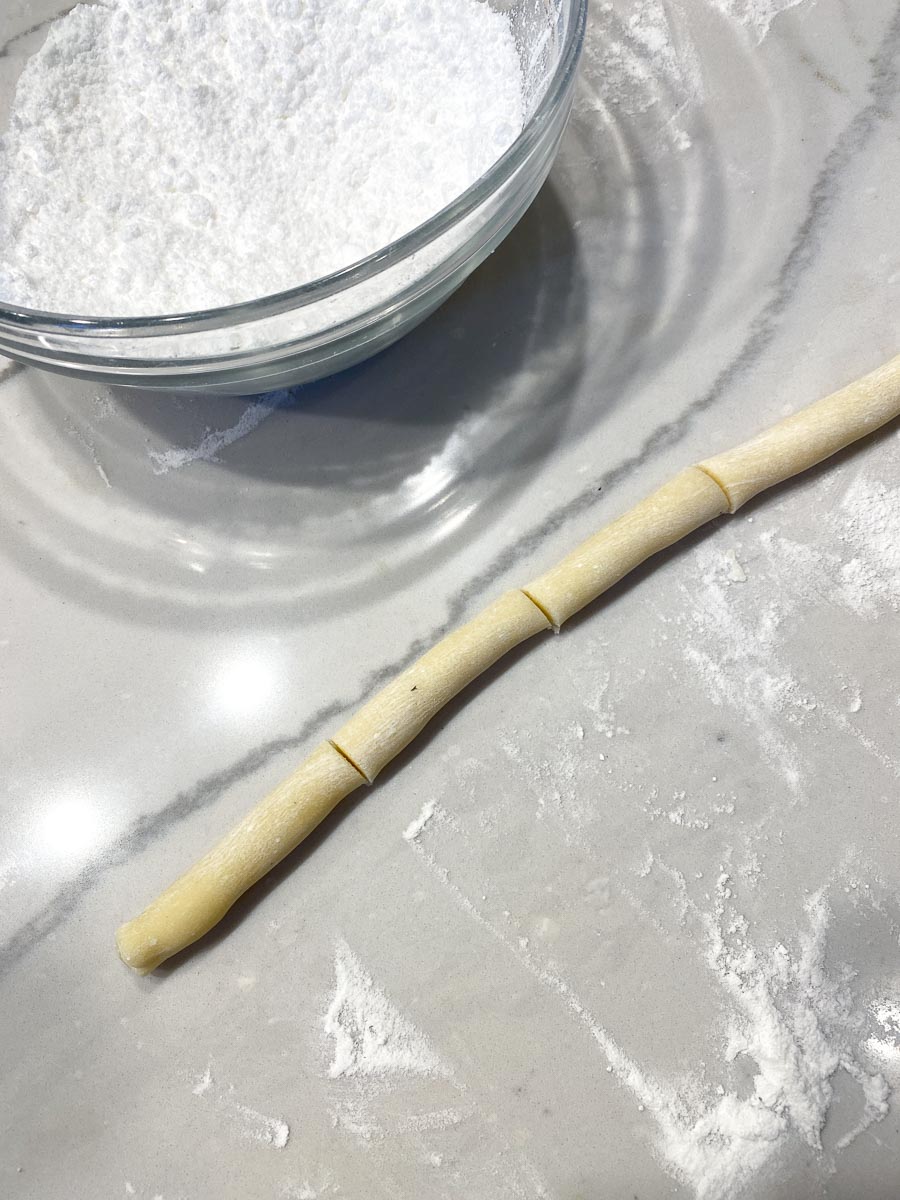
Cut into segments about 2 ½-inches (6 cm) long. Pinch and roll the ends to taper.
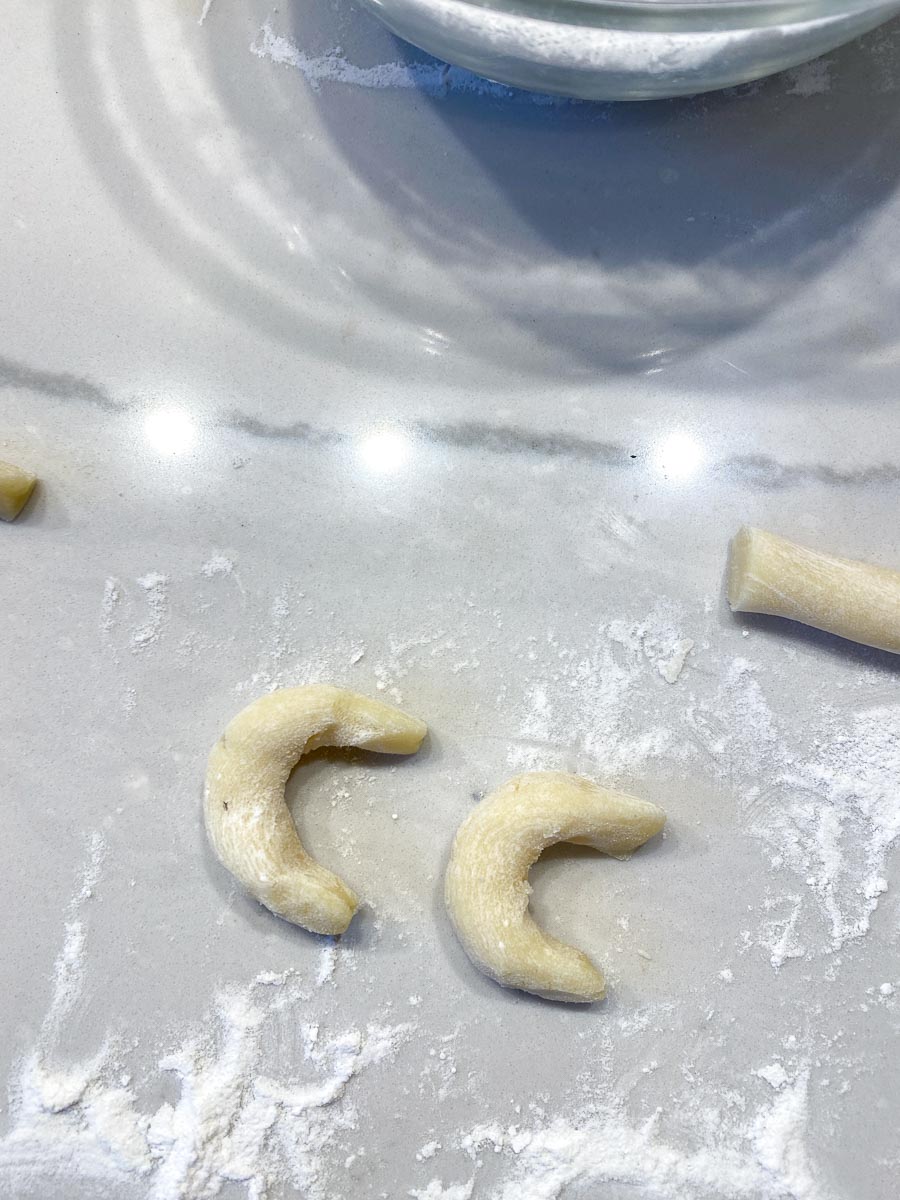
Place on prepared cookie sheets about 2-inches (5 cm) apart and bend into a crescent shape. Repeat with remaining dough.

Bake for about 10 to 12 minutes or until light golden brown around the edges and on the bottoms.

Slide parchment onto racks to cool cookies for a minute or two. While still warm, carefully roll each cookie in the vanilla sugar mixture until thoroughly coated and replace on parchment on rack to cool completely. You can also sift the topping all over the warm cookies on the pan, then roll them around in the excess.

For an alternate finish, do not roll in sugar and instead melt semisweet chocolate and dip the tips of the crescents into the chocolate, then place on parchment lined pan and allow chocolate to set.

Cookies may be stored at room temperature in an airtight container for up to 2 weeks.
FODMAP Information
Our recipes are based on Monash University and FODMAP Friendly science.
- Almonds: Both Monash University and FODMAP Friendly have lab tested whole almonds, and their results vary from one another. Monash says that a Green Light low FODMAP portion is 10 whole almonds at 12 g, but a high FODMAP portion is 20 whole almonds at 24 g. FODMAP Friendly gives them a “Pass” at 30 g or ¼ cup.
- Almond Meal: Monash University has tested almond meal (ground almonds) and states that a low FODMAP serving size is ¼ cup or 24 g.
- Butter: Both Monash University and FODMAP Friendly have lab tested butter. Monash states that a low FODMAP Green Light portion is 1 tablespoon or 19 g and also states that “butter is high in fat and does not contain carbohydrates (FODMAPs)”. FODMAP Friendly gives it a “Pass” at 1 tablespoon or 19 g. Both recommended serving sizes are presented as part of healthy eating guidelines, not as maximum FODMAP serving size. Fat can affect guy motility and trigger IBS symptoms in some people. Eat to your tolerance.
- Chocolate: Monash University has lab tested dark, milk and white chocolate all have low FODMAP amounts: 85% dark at 20 g; dark at 30 g; milk at 20 g; white at 25 g.
- Eggs: Eggs are high in protein and do not contain carbohydrates, according to Monash University.
- Sugar: Monash University and FODMAP Friendly have both lab tested white, granulated sugar. Monash states that a Green Light low FODMAP serving size of white sugar is ¼ cup (50 g). FODMAP Friendly simply states that they have tested 1 tablespoon and that it is low FODMAP. Regular granulated white sugar is sucrose, which is a disaccharide made up of equal parts glucose and fructose. Sucrose is broken down and absorbed efficiently in the small intestine.
Please always refer to the Monash University & FODMAP Friendly smartphone apps for the most up-to-date lab tested information. As always, your tolerance is what counts; please eat accordingly. The ultimate goal of the low FODMAP diet is to eat as broadly as possible, without triggering symptoms, for the healthiest microbiome.

Low FODMAP Vanilla Crescents
Our Low FODMAP Vanilla Crescents are buttery, a bit crumbly and made with finely ground almonds or almond flour. The dough itself is not very sweet, but the sugary coating creates a sweet treat. You can also dip them in dark chocolate, as an alternative finish.
Low FODMAP Serving Size Info: Makes about 40 crescents; 2 cookies per serving; 20 servings
Ingredients:
Cookie:
- 1 ¾ cups (254 g) plus 2 tablespoons low FODMAP gluten-free all-purpose flour, such as Better Batter
- 4- ounces (115 g) fine blanched almond flour, such as Bob’s Red Mill brand
- Pinch salt
- 1 cup (226 g; 2 sticks) unsalted butter, at room temperature, cut into pieces
- 1/2 moist vanilla bean, or 1 teaspoon vanilla extract
- 3/4 cup (68 g) sifted confectioners’ sugar
- 2 large egg yolks
Topping:
- 1/4 cup (50 g) granulated sugar
- 1/4 cup (23 g) sifted confectioners’ sugar
- 1/2 moist vanilla bean, or use ¼ cup (50 g) vanilla sugar, instead of granulated sugar
- Semisweet chocolate; optional
Preparation:
-
For the Cookie: Place flour, almond flour and salt in bowl in a bowl and whisk together to aerate and combine.
-
Place butter in bowl of mixer and beat with flat paddle on medium-high speed until creamy, about 2 minutes. Split the vanilla pod lengthwise with a sharp knife, then scrape half the vanilla bean seeds into the butter using a butter knife or spoon (reserve other half for topping). Beat butter for 1 minute to blend in the vanilla beans – or beat in 1 teaspoon vanilla extract in lieu of bean. Add confectioners’ sugar and continue beating until light and fluffy, about 3 minutes, scraping down the bowl once or twice. Beat in egg yolks.
-
Turn machine off, add about one-third of the flour mixture, then turn machine onto low-speed. Gradually add remaining flour, mixing just until blended, scraping down bowl once or twice. Scrape dough onto large piece of plastic wrap. Use wrap to help shape a large, flat disc then cover with plastic wrap. Refrigerate at least 1 hour or until firm enough to roll. Dough may be refrigerated overnight in which case you may need it to soften a bit at room temperature before shaping. You may freeze dough up to 1-month double wrapped in plastic wrap; defrost in refrigerator overnight before proceeding.
-
For the Topping: Place granulated sugar and confectioners’ sugar in bowl of food processor fitted with metal blade. Split the remaining half vanilla pod lengthwise with a sharp knife, then scrape the vanilla bean seeds into the sugar mixture using a butter knife or spoon. Pulse on and off several times to disperse vanilla bean seeds. Pour vanilla sugar into a small bowl; set aside.
-
Preheat oven to 350°F (180°C). Line two half-sheet pans with parchment paper.
-
Roll dough between your palms or on work surface into 1/2-inch (12 mm) wide logs. Cut into segments about 2 ½-inches (6 cm) long. Pinch and roll the ends to taper. Place on prepared cookie sheets about 2-inches (5 cm) apart and bend into a crescent shape. Repeat with remaining dough.
-
Bake for about 10 to 12 minutes or until light golden brown around the edges and on the bottoms. Slide parchment onto racks to cool cookies for a minute or two. While still warm, carefully roll each cookie in the vanilla sugar mixture until thoroughly coated and replace on parchment on rack to cool completely.
-
For an alternate finish, do not roll in sugar and instead melt semisweet chocolate and dip the tips of the crescents into the chocolate, then place on parchment lined pan and allow chocolate to set. Cookies may be stored at room temperature in an airtight container for up to 2 weeks.
Notes:
FODMAP Information
Our recipes are based on Monash University and FODMAP Friendly science.
• Almonds: Both Monash University and FODMAP Friendly have lab tested whole almonds, and their results vary from one another. Monash says that a Green Light low FODMAP portion is 10 whole almonds at 12 g, but a high FODMAP portion is 20 whole almonds at 24 g. FODMAP Friendly gives them a “Pass” at 30 g or ¼ cup.
• Almond Meal: Monash University has tested almond meal (ground almonds) and states that a low FODMAP serving size is ¼ cup or 24 g.
• Butter: Both Monash University and FODMAP Friendly have lab tested butter. Monash states that a low FODMAP Green Light portion is 1 tablespoon or 19 g and also states that “butter is high in fat and does not contain carbohydrates (FODMAPs)”. FODMAP Friendly gives it a “Pass” at 1 tablespoon or 19 g. Both recommended serving sizes are presented as part of healthy eating guidelines, not as maximum FODMAP serving size. Fat can affect guy motility and trigger IBS symptoms in some people. Eat to your tolerance.
• Chocolate: Monash University has lab tested dark, milk and white chocolate all have low FODMAP amounts: 85% dark at 20 g; dark at 30 g; milk at 20 g; white at 25 g.
• Eggs: Eggs are high in protein and do not contain carbohydrates, according to Monash University.
• Sugar: Monash University and FODMAP Friendly have both lab tested white, granulated sugar. Monash states that a Green Light low FODMAP serving size of white sugar is ¼ cup (50 g). FODMAP Friendly simply states that they have tested 1 tablespoon and that it is low FODMAP. Regular granulated white sugar is sucrose, which is a disaccharide made up of equal parts glucose and fructose. Sucrose is broken down and absorbed efficiently in the small intestine.
Please always refer to the Monash University & FODMAP Friendly smartphone apps for the most up-to-date lab tested information. As always, your tolerance is what counts; please eat accordingly. The ultimate goal of the low FODMAP diet is to eat as broadly as possible, without triggering symptoms, for the healthiest microbiome.
Nutrition
All nutritional information is based on third-party calculations and should be considered estimates. Actual nutritional content will vary with brands used, measuring methods, portion sizes and more. For a more detailed explanation, please read our article Understanding The Nutrition Panel Within Our Recipes.







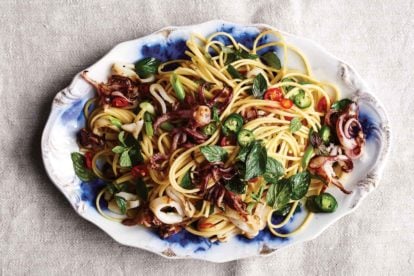
Thank you! My grandmother always made these, I learned then from her — her famous recipe from a church cookbook she bought traveling West, meaning someone else’s family recipe became ours. And then my FIL told me his Tante Bertha used to make them!
I used to stress about the crescent shapes being just so. Our recipe made A LOT. So then I used a cookie scoop instead. These travelled (or mailed) better, but it was like I had comitted sacriledge the way everyone responded. And yet they dosappeared as fast as usual!
I love hearing about family traditions! Maybe this will become a new one?
I think it will! And as for vanilla sugar, I get mine at Penzeys (dotcom)
Husband’s family is Lithuanian, mine German…both arrived at this cookie!
My husband’s favorite cookie though is kolachi cookies. Have you a recipe for those? (Sorry any typos, I’m new to low vision, which makes typos easy and my screen rendering software messes up spellcheck.)
I have one in my pre-FODMAP cookie books but I will have to get to work on a low FODMAP one! If you have a family recipe, you could use our FODMAP IT!™ request and I might take a look.